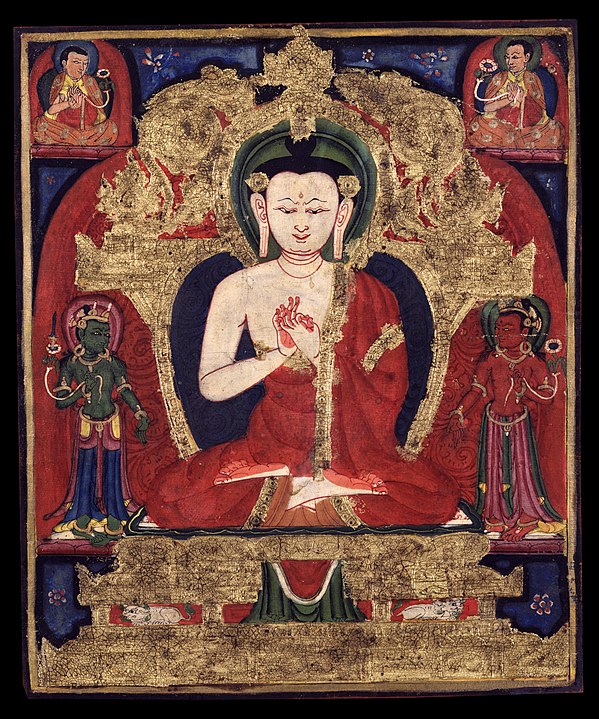
The History and Evolution of Thangka Art
Share
Thangka art, one of the most revered forms of Tibetan Buddhist expression, is not only a visual masterpiece but also a spiritual tool deeply embedded in religious practice. The history of thangka painting is rich with cultural significance and spiritual depth, illustrating Buddhist teachings through vibrant imagery. In this post, we'll explore the origins of thangka art, its evolution over centuries, and its lasting impact on both Tibetan culture and Buddhist traditions worldwide.
(In the image: Buddha Vairocana, the “Resplendent One”. Pigments on cloth, 14th century)
Origins of Thangka Art
The roots of thangka art can be traced back to around the 7th century CE, when Buddhism began to flourish in Tibet. Influenced by Indian, Nepalese, and Chinese artistic traditions, thangkas originally served as visual aids for teaching Buddhist principles to those who could not read. Thangkas were portable scroll paintings, making them ideal for use in monasteries and nomadic communities, where they could be easily transported and displayed for religious ceremonies.
Thangka art is primarily characterized by its depiction of deities, mandalas, historical events, and sacred landscapes, all with intricate symbolism. Early thangkas were created using natural pigments derived from minerals, plants, and even precious stones, giving them their distinct, vibrant colors.
Cultural and Spiritual Significance
Throughout Tibetan Buddhist art history, thangkas have held a special place in religious practice. Each thangka serves as a meditation tool or a teaching aid, designed to guide the practitioner toward enlightenment. The iconography within the paintings often illustrates various deities, bodhisattvas, and scenes from the life of the Buddha. By meditating on these images, practitioners can deepen their understanding of Buddhist teachings and develop compassion, wisdom, and mindfulness.
The creation of a thangka is itself a spiritual practice. Artists traditionally receive years of training to master the precise techniques required for producing these sacred paintings. Each stroke is purposeful, with measurements and proportions dictated by ancient texts. The production process is often considered a form of meditation, with the artist praying and focusing on spiritual discipline throughout the creation.
Evolution of Thangka Art Over Time
Thangka art has evolved considerably over the centuries, adapting to changes in culture, politics, and artistic trends while maintaining its spiritual essence. Early thangkas were simpler in composition, often focusing on one deity or scene. However, as the art form developed, the complexity of thangka designs increased, with later pieces featuring intricate mandalas, elaborate landscapes, and multi-deity compositions.
During the Tibetan Empire (7th-9th centuries), thangkas were heavily influenced by Indian and Nepalese Buddhist art. However, after the decline of the Tibetan Empire, Tibet entered a period of isolation, during which its unique artistic identity began to emerge. By the 11th century, Tibetan artists were producing thangkas that reflected a distinct Tibetan Buddhist artistic style, marked by its use of bold, vivid colors and detailed iconography.
In the 17th century, the influence of the Chinese Ming and Qing dynasties introduced new techniques and stylistic elements into thangka painting. This included the use of silk brocade borders and more refined brushwork. Despite these external influences, thangkas retained their core purpose as spiritual tools and artistic representations of Buddhist cosmology.
Modern Thangka Art
While traditional thangka painting continues to thrive, the 20th century brought significant changes to its practice. Following the Chinese occupation of Tibet in 1959, many Tibetan artists were forced to flee to neighboring countries such as India and Nepal, where they continued their craft. As Tibetan culture spread across the globe, so too did the popularity of thangka art, which gained recognition among collectors, spiritual practitioners, and art enthusiasts worldwide.
Today, contemporary thangka artists continue to produce traditional works while also experimenting with modern techniques and materials. Some artists blend elements of modern art into their thangkas, incorporating new colors, forms, and themes while maintaining the spiritual significance of the practice. The result is a fusion of old and new, allowing thangka art to evolve with the times while honoring its ancient roots.

The Enduring Legacy of Thangka Art
Despite the changes in technique and style over the centuries, the spiritual and cultural significance of thangka art remains unchanged. Each thangka is a visual representation of the Buddha’s teachings, a guide to enlightenment, and a meditation tool used by practitioners all over the world.
As the global interest in Tibetan Buddhism and mindfulness practices grows, so too does the appreciation for thangka art. Collectors and spiritual seekers alike are drawn to the deep symbolism, intricate beauty, and meditative power of these paintings. Thangkas continue to be revered not only as works of art but as sacred objects that bridge the gap between the material and spiritual worlds.
In conclusion, the history of thangka painting reflects the rich cultural and spiritual heritage of Tibet. From its early beginnings as a portable teaching tool to its current status as an internationally celebrated art form, thangka art has evolved over time while maintaining its deep connection to Tibetan Buddhism. As new generations of artists take up the craft, thangka painting will undoubtedly continue to evolve, preserving its ancient traditions while adapting to the changing world.
By understanding how thangka art has evolved over time, we can better appreciate its role in Tibetan Buddhist culture and its enduring power to inspire and guide practitioners on their spiritual journeys.
By ChatGPT
Picture attribution
